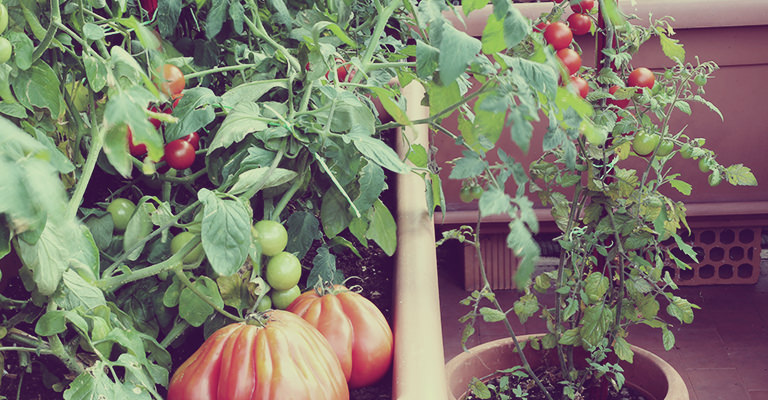Tomatoes are arguably the most popular crop for the home gardener. Even folks who don’t grow any other produce will often have at least a container or two of tomatoes. Tomatoes like at least 8 hours of direct sun each day, but if your garden space is lacking in the sun department, fear not.
There are different ways to grow tomatoes; and while sun is the common denominator, many methods make it easy to situate your plant in the most beneficial lighting situations available.
Here are 4 ways to grow tomatoes in your garden or available space.
1- Grow them in the garden and let them sprawl. Obviously, you can grow tomatoes in the garden proper. If you tend towards the lazy, you can even grow them without supports. No tying back or pruning is required. Just allow the plant to sprawl along the ground.
The downside of this method is that fruit touching the ground is a heck of a lot more likely to become afflicted with soil-borne diseases and pests. If you are going to try this method of growing, lay a layer of mulch around the plant to keep the fruit from touching the soil and choose smaller, determinate types of tomato.

2- Grow them in a cage or tie them up. If you want to minimize the risk of damage done to the fruit by dragging it along the soil, you will probably cage or otherwise support the plants. You can purchase cages or build them yourself. Nothing like a DIY project!
Homemade cages need 4- to 6-inch mesh, cattle fencing or wire mesh used in reinforcing concrete walls works. Bend a 6-foot length of the wire into a cylinder that is 22 inches across. Stake the cylinders around the plant base. The good thing about caging tomatoes is that the fruit is off the ground and the plant is shaded, thus protected from sun damage (sunscald).
Other supports can be used, such as stakes, or anything you can think of to repurpose. When you stake the plants, prune out all of the sucker shoots. These can just be snapped off when they are still small. The goal is to limit the plant to just a couple of primary stems. Tie the primary stems to the support using soft string, thin strips of cloth, old pantyhose. The downside to pruning to just a couple of strong branches is a reduced yield and a plant that is more susceptible to sunscald and blossom end rot.

3- Grow them in containers or hang upside down. If you don’t have an appropriate spot in the garden to grow tomatoes, some varieties thrive in containers. Containers can be your garden variety pots, or even buckets or bags that are transformed to grow tomatoes upside down.
Both are space saving and make use of sunny lanais, eaves or decks, especially if the rest of the yard is shaded. Keep in mind that container grown plants, in general, need more frequent watering than those in the ground. If you are growing in containers, smaller varieties like roma or cherry tomatoes tend to do better than the larger varieties.

4- Grow them indoors. You can also grow your tomatoes indoors. Use unglazed pots with good drainage holes and place the plants in a well-lit area, preferably a south-facing window. Be sure the window isn’t drafty and the temperature in the area stays at least 65 degrees F. (18 C.), if not more. As the plants mature, temperatures should be increased to between 75-85 degrees F. (23-29 C.) ideally.
The problem with growing tomatoes indoors, is the lack of pollinators. No worries though, as this is where you and a cotton swab come into play. You will play the part of a bee and gently transfer pollen from flower to flower. As with other container-grown tomatoes, the smaller varieties the better – small upright cultivars such as Red Robin, Tiny Tim, Toy Boy, and Florida Petite are ideal.
Subscribe to our newsletter to receive our gardening tips, news and more directly in your inbox! Fill in the form below. Please note that fields with an * are required.